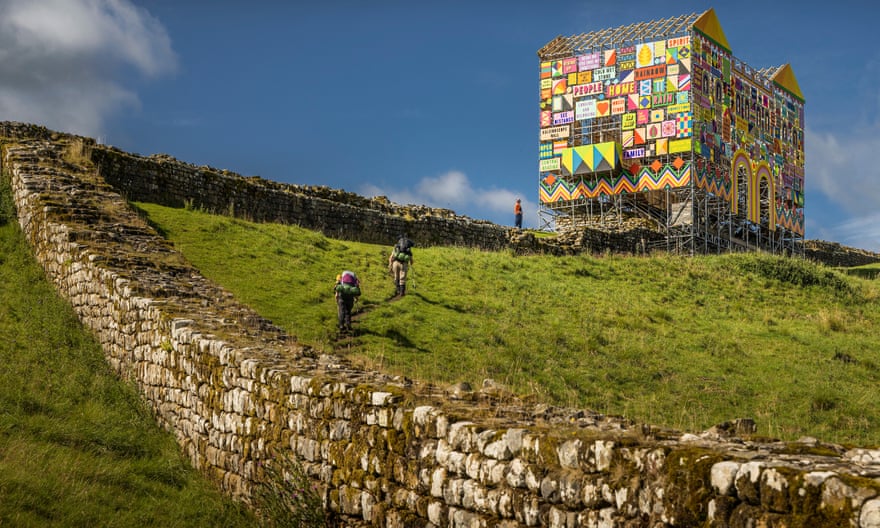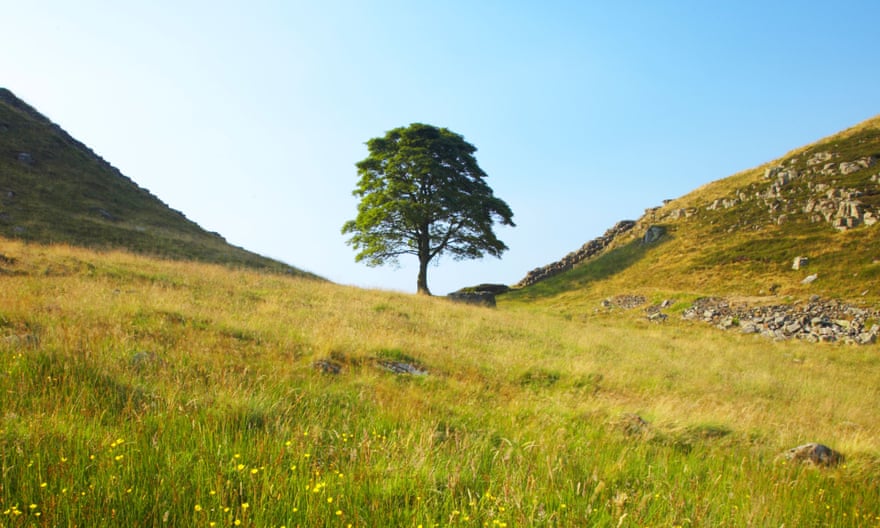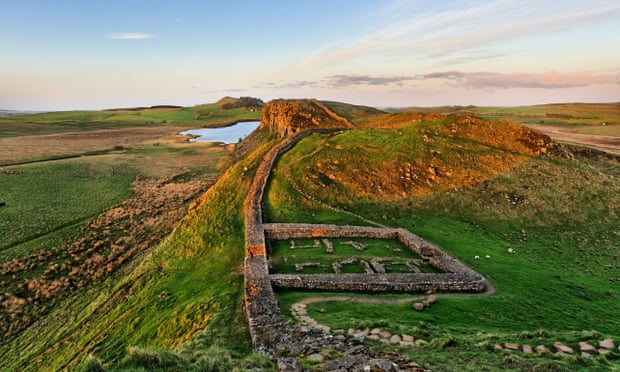
What would the Romans say? A brilliant new ‘art fort’ brightens up Hadrian’s Wall | Northumberland holidays
“I don’t think I’ve ever seen it so busy!” declares my dad as we pull into the car park of Housesteads, which sits along Hadrian’s Wall, one of the best-preserved Roman forts in Britain. He’s right: the car park is rammed and the entrance to the site is unusually crowded. Tourists with backpacks sit on picnic benches eating cake from the cafe, while a dad reads aloud the noticeboards to his small children.
This buzz is, in part, probably due to it being an exceptionally sunny day during the school holidays. But there’s another factor: Housesteads has a new, temporary art installation, part of a year-long series of events celebrating 1,900 years since building on Hadrian’s Wall began in AD122, under the instruction of the emperor Hadrian.
Designed by artist Morag Myerscough with help from the local community, the artwork – called The Future Belongs to What Was As Much As What Is – consists of a colourful, fortress-like structure made from scaffolding. At about 16 metres wide and 9 metres tall, it’s large enough to be seen from the B-road running parallel to the wall, and reimagines the northern gatehouse of this fort, built directly on top of its remains.
A trip to Housesteads was a family favourite throughout my childhood. Back then, mum and dad would pack my two brothers and me into the car – sometimes with a couple of other chaotic children in tow – and drive us out to one of the forts along the 73-mile wall, stretching from Wallsend to Bowness-on-Solway, once the north-west frontier of the Roman empire, in the hope of providing us with some entertainment.

While Housesteads is often cited as an example of the standard “playing card” plan of a Roman auxiliary fort, its rectangular shape served us with a different – and, in our eyes, far better – purpose. It acted as the perfect perimeter for playing hide and seek. Other forts worth visiting, where I’ve also collected memories to make me smile, include Birdoswald, Chesters and, just down the road, Vindolanda, home to the Vindolanda tablets, some of the oldest handwritten documents in Britain.
Today, my parents and I take the familiar half-mile path to Housesteads, following the natural dip in the land, before a steep ascent to the ticket desk and museum. Just to the south of the fort, near the path leading to its entrance, there are the remains of the vicus, the town where the soldiers’ families lived and worked.
Along the way, Myerscough’s structure bobs in and out of view. Her artwork is arresting, adding a welcome flamboyance to what is often a desolate, grey landscape. The construction also highlights – quite literally, as fluorescent paint coats the exterior – the Romans’ use of colour. For the buildings of ancient Rome were not finished as the gleaming white marble remains we see today, but were brightly painted.
Housesteads is exposed to the elements, so many of my childhood memories consist of being lashed by the wind and rain. Mum would often harness this dire weather as a way of getting us to consider the harsh conditions faced by the Roman army who built the wall from stone and turf, while likely living in leather tents. This bitter climate is evident, too, in the lifespan of Myerscough’s installation: the plan is for it to stay up until the end of October, but only if the weather allows it.
Inside the fort, the installation seems to have injected a garish energy that I’ve not encountered here before. Children play among the remains in the sunshine, tourists take photographs, and a National Trust volunteer carries out a guided tour. Among the site’s highlights are the latrines – some of the finest toilets in Roman Britain; the granary, where the still-visible stone pillars once supported a raised floor to help keep food dry; and the luxurious house of the commanding officer, complete with the remnants of a hypocaust – the Romans’ version of central heating.

Hanging from Myerscough’s installation are flashy placards carrying mostly optimistic phrases – I’m drawn to “floodgates of love”, “family” and “everybody’s welcome” – many painted by communities living near the wall, including quotes from local poet Ellen Moran. From one of its two balconies I look across the sprawling wilderness: the installation reveals views possibly last seen by the soldiers on duty 1,600 years ago, when the fort was abandoned as the Roman empire began to crumble.
The scenery is bleak, but weirdly stunning: soothing swathes of woodland and dry-stone walls – many of them built using stones from Hadrian’s Wall – and the odd sheepfold among the fields. Those wanting to explore it more can also do an 8-mile loop from Housesteads down to Sycamore Gap, a striking tree sitting in a dramatic dip of land, and an attraction in its own right since its appearance in the 1991 film Robin Hood: Prince of Thieves. From here, the path goes via the prominent remains of Milecastle 39 (or Castle Nick), before looping around to give views across Crag Lough and Whin Sill, an imposing, volcanic formation of layered rock, with Hadrian’s Wall running along the top.
“I know it’s totally out of context, but it’s great isn’t it?” says volunteer guide Steve, as we stand beside the north gate after his tour, watching excited children run in and out of the installation. “Younger generations can go in there and have a look at things, muck about. I think the only sad thing from their point of view is that they’re not allowed to climb the scaffolding and go up to the top!”
Our day ends with an obligatory visit to the cafe near the entrance, where we join those on the picnic benches outside, chatting about what we’ve just seen. Indeed, Myerscough’s artwork has ignited the imaginations of visitors to this fort. While the installation is wonderfully joyous – much needed in these times and in this landscape – it’s also practical, giving a real sense of the scale of the original gatehouse. It’s a colourful reminder of this brutally exposed edge to Rome’s once-vast empire.
Five more events celebrating Hadrian’s Wall’s 1,900th anniversary

Night Attack at Chesters Roman Fort
A night-time re-enactment of an attack from communities living north of the wall, with actors dressed in Roman army regalia.
27-28 August, english-heritage.org.uk
Catapulta! at Birdoswald Roman Fort
Another re-enactment, this time of Roman soldiers competing in an artillery competition, with the crowd encouraged to cheer on their favourite.
27-29 August
W’all Love the Wall, Tyne Theatre & Opera House
A new comedy sketch show by north-east-based writers’ group Sun of a Gun, in partnership with Tyne Theatre Productions, promising “masonry-related humour” inspired by Hadrian’s Wall.
4 September, eventim.co.uk
Guided walk: Greenlee Lough and Hadrian’s Wall
A free, 11-mile guided walk by Hexham Ramblers, taking in the scenery of Housesteads, Sycamore Gap, Whin Sill and Crag Lough.
25 September, walk detail at Ramblers
Open Day at Ravenglass Roman Fort and Bath House
An open day at this Roman fort in west Cumbria, which has a well-preserved bathhouse, with family-friendly activities, dressing up and Roman board games.
24 September
